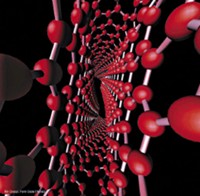Advertisement
Grab your lab coat. Let's get started
Welcome!
Welcome!
Create an account below to get 6 C&EN articles per month, receive newsletters and more - all free.
It seems this is your first time logging in online. Please enter the following information to continue.
As an ACS member you automatically get access to this site. All we need is few more details to create your reading experience.
Not you? Sign in with a different account.
Not you? Sign in with a different account.
ERROR 1
ERROR 1
ERROR 2
ERROR 2
ERROR 2
ERROR 2
ERROR 2
Password and Confirm password must match.
If you have an ACS member number, please enter it here so we can link this account to your membership. (optional)
ERROR 2
ACS values your privacy. By submitting your information, you are gaining access to C&EN and subscribing to our weekly newsletter. We use the information you provide to make your reading experience better, and we will never sell your data to third party members.
Environment
Nanotech Strategy
Prioritizing federal efforts for studying health and safety of nanomaterials evolves
by David J. Hanson
March 3, 2008
| A version of this story appeared in
Volume 86, Issue 9

Ever since manufacturers began using engineered nanomaterials in industrial processes and commercial products, some observers have raised concerns about the potential for these materials to be hazardous to human health or the environment. These worries prompted the National Nanotechnology Initiative (NNI), the consortium of federal agencies that study or regulate nanomaterials, to devise a research strategy to answer questions about potential environmental, health, and safety (EHS) consequences of this new technology.
The latest report by NNI's Nanotechnology Environmental & Health Implications (NEHI) working group—established to monitor the federal research in the field and to set agency priorities—does just that. Although the report offers a more focused framework of research needs and priorities than have some past efforts, some in the field say the report overstates how much EHS research is going on, particularly when it comes to human exposure studies.
Clayton Teague, director of the National Nanotechnology Coordination Office, is more upbeat. "This research strategy is the result of a terrific team effort led by the NEHI working group," he says. "It reflects a strong consensus and commitment among the NNI member agencies on the roles they will assume to move the federal efforts in nanotechnology-related EHS research forward. The quality of the document demonstrates that the NNI is working hard to understand nano EHS issues in a systematic and coordinated fashion."
On the basis of estimates provided by the relevant federal agencies, the government will spend nearly $1.5 billion on nanotechnology projects in 2008, with $58.6 million devoted to EHS research. In its study, however, NEHI compiled a database of all federally funded nanotech research and found that $67.8 million was spent in 2006 on 246 EHS-related research projects at seven agencies. This amount includes all projects that have an EHS component of any kind.
To help agencies spend their money wisely, the NEHI strategy focuses on five major research areas: instrumentation and analytical methods, nanomaterials and human health, nanomaterials and the environment, human exposure assessment, and risk management methods. Much of the report, titled "Strategy for Nanotechnology-Related Environmental Health and Safety Research," is devoted to descriptions of current research activities in each of these categories.
For example, the majority of the research funds, and the greatest number of projects, are in the first two categories. Work in those areas tends to be heavy in basic research on the characteristics of the nanomaterials rather than on exposure studies and risk management protocols.
The revised strategy recognizes that more work is needed in some areas and makes specific recommendations for each of the broad categories. These include improved analytical methods for identifying and measuring nanomaterials, development of a database of nanomaterial properties, development of methods for quantifying human responses to exposures, and characterizing the health of exposed persons and the environment.
Critics of NEHI's proposed strategy for EHS research point out that relatively little research attention has been paid to the measurement of actual human exposures. Some critics also complain that the government has used too generous a definition in considering what constitutes an environmental or health study and that, as a result, the new report gives an inflated view of the government's effort.
"The truth is that while the NEHI has made significant strides in this latest effort to present an improved nanotechnology risk research strategy, only about five of the more than 240 identified research projects focus on exposure assessment–which directly affects workers," claims David Rejeski, director of the Project on Emerging Nanotechnologies at the Woodrow Wilson International Center for Scholars, in Washington, D.C. "These are the people who are on the front line and most likely to be exposed to potentially hazardous nanomaterials."
The criticism is echoed by the environmental community. Richard A. Denison, senior scientist with the group Environmental Defense, says the government needs to devote more resources to exposure assessments.
"We have hundreds of nanoproducts on the market, and many clearly pose direct exposure risks, such as cosmetics and some food packaging. We know very little about the hazard from long-term exposure to these materials," Denison says.
One reason for this unbalanced research focus is the political makeup of the nanotech consortium, Denison says. "The odd distribution of environmental and health projects we see may have to do with the established research priorities of the agencies in NNI," he says. For example, the National Science Foundation funds a lot of the projects yet it is seen as emphasizing the applications for nanotechnology. The National Institute of Occupational Safety & Health, on the other hand, gets much less research funding than NSF but should be getting more for nanotech exposure studies, Denison says.
The NNI research priorities do have support from the research community. "These priorities are absolutely the areas where the environmental and health communities say that research needs to be done soon," says Kristen Kulinowski, executive director of the Center for Biological & Environmental Nanotechnology at Rice University and director of the International Council on Nanotechnology.

Most nanotech health and safety research funds go for analytical methods.
The NNI strategy is a useful tool for organizing a very complex problem, she says, and it allows researchers in the field to see where the federal investments in nanotech are going to go. "We need to do a lot of groundwork before we can say if these nanomaterials are going to have any impact," Kulinowski says, noting that much of the research that has to be done should focus on the nanoparticles themselves and not the materials containing them. "It's all about the chemistry," she says.
"While it may not look like some of the research being done will help us understand environmental problems, it is critical to understand what is out there," Kulinowski says. "Basic research tools, such as particle detection and characterization, are very relevant and without them we would have no quality control or any way to compare lab data to bench results."
She says that the various federal agencies involved in this research are going to have to work together to achieve the quickest results, but some have done this before. "We have to remember that so much of what needs to be done is still in the discovery stage," she adds.
As the field moves forward, Denison raises another concern regarding the ability of the various agencies involved in the research program to work together. "I see that there may actually be an internal conflict among the agencies at NNI between those that promote and develop this technology and those that are supposed to regulate the possible environmental and health impacts," he says. "Because of this, we need an independent review of the research priorities."
That review should be done by the National Academy of Sciences, Denison says. "A wide number of stakeholders in this issue believe that the federal government needs help in developing a true strategy," he says. An NAS review should include recommendations for how much money should go to various research areas and ways to monitor the results of the research. He adds that Congress appropriated funds for the Environmental Protection Agency to contract with NAS this year to develop such a strategy, but there has been no action by EPA yet.




Join the conversation
Contact the reporter
Submit a Letter to the Editor for publication
Engage with us on Twitter